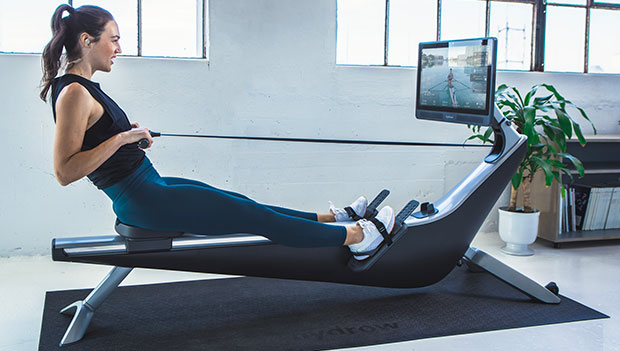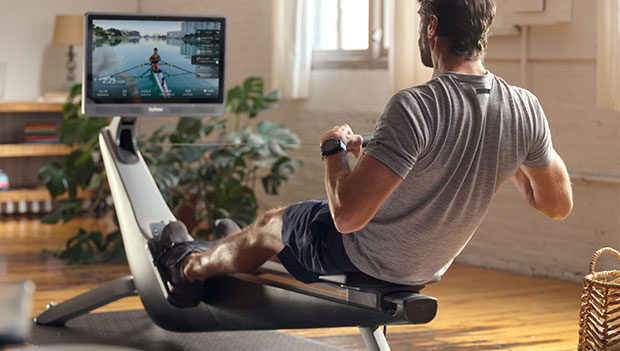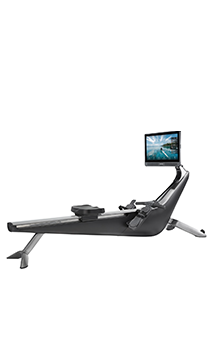
By clicking on the product links in this article, we may receive a commission fee at no cost to you, the reader. Sponsorships and affiliate commissions help support our research so we can help you find the best products. Read the full affiliate disclosure here.
The benefits of rowing for runners go far beyond just breaking up the tedium of your daily run. If your training is starting to feel flat or your goal is making performance and efficiency gains with your running—as well as help prevent injuries through better form and more power—then incorporating rowing workouts (via a rowing machine) into your training program can be exceptionally effective. From active recovery to strengthening the hips and hamstrings, non-impact rowing workouts pack an incredible training punch into a concentrated dose of time.
The 3 Key Performance Benefits of Rowing for Runners
A common misconception is that rowing only works your arms. When you adhere to proper technique, rowing is a hip-hinging workout similar to the deadlift, targeting the muscles of your posterior chain, in particular powerhouse muscles like the hips and hamstrings.
Sure, you'll exercise the arms, shoulders, and lats, but expect to feel it in your back, hips, and hamstrings, as well. Here's why that muscle engagement is especially beneficial for runners:
1. Reduced risk of injury through improved posture
"Runners tend to be all-quad and don't normally tap into their back muscles," says Jay Dicharry, MPT, strength expert, and author of Running Rewired. As Dicharry emphasizes, runners with weak posterior chains fail to access reservoirs of strength and endurance in large muscles like the hips and hamstrings, forcing them to rely on the smaller quadriceps muscles.
Being "all-quad" can lead to poor running posture, stability, and over-striding. These weaknesses can place added stress on your knees. Not only does poor posture shut off your power supply, but the weak mechanics also open the door to myriad injury problems.
Rowing workouts offer a solution by helping runners to "find their hips," as Dicharry puts it, waking up and strengthening the posterior chain can help enhance stability and transition runners away from hunched, injury-inducing forms.
2. Increased Force Production
A strong posterior chain also means improved athletic performance. Instead of weakly pulling yourself along with your quads, a runner can use the powerful running muscles in the body to push. Think of it this way: there is no reason distance runners can't rely on their hip drive and hamstrings the way sprinters can. Rowing for your distance running opens up a flow of power that can lead to more speed with less effort.
3. Improved Endurance
You can also train your aerobic system on the rower at the same time you gain strength and power. A 2015 study in the Journal of Strength and Conditioning Research showcased how rowing workouts offer a superior form of cross-training, boosting both strength and cardiovascular endurance. For the time-stressed runner, rowing workouts can either be an effective substitute for a run or a low-impact addition.

How to Use a Rowing Machine
The key to cashing in on all that rowing has to offer can be summed up with one word: technique. Like lifting a heavy weight off the floor, if you perform with the proper mechanics, you will become stronger and reduce your chances of getting injured, while poor mechanics can lead to the opposite.
The essential first step into rowing is mastering good technique. Here's a breakdown of the rowing stroke:
The Catch
Start by sitting tall on the machine with your arms out straight, and activating your core. Try to picture an image of power flowing from your core muscles (muscles of your trunk) out through your extremities (arms and lower legs). Now move your midline toward your thighs. You will want your shins vertical, your heels slightly lifted, and your upper body gently tilted forward. Next, engage your lats and prepare for the drive.
Drive
Next you're going to drive through your legs. Again, imagine the flowing of power from the core to the extremities as you retain the forward tilt and push with your legs through your heels into the rower. Keep your movement smooth as you fully extend your legs. This is the phase of rowing when your hips and hamstrings are fully activated and put to work. Then initiate the hip-hinge part of the movement, and rock your core backward with control.
The Finish
After your upper body extends past the vertical line, it's time to bring the arms into the picture. With the midline continuously activated and braced, pull the handle smoothly toward your sternum.
Recovery
The recovery retraces the same movement pattern you just used from the catch to the finish but at a slower speed. Fluidly relax your arms to a full extension, then allow your upper body to move forward (core continuously braced) as your knees bend back towards your starting position.
Rowing Workouts for Runners
There are several dynamic workouts that you can perform on a rowing machine, from blasting through a 500-meter timed trial to a long, slow endurance workout. Here are a few examples:
Active Recovery
Rowing is an excellent workout following a race, long training run, or brutal track workout. Rather than a 30- to 40-minute jog, try rowing for 20 minutes to an hour at a pace that you can carry on a conversation and keep your heart rate at 60- to 70-percent of your max heart rate.

Speed Workout
By modulating the time and intensity variables, rowing can turn into an assortment of speed or speed-endurance-type workouts, including anaerobic threshold and VO2-max targeted training.
Anaerobic Threshold Training
Perform a thorough warm-up that includes 30-second bursts of speed (like the striders you perform before a track workout). One example of an anaerobic threshold (AT) workout would be long intervals, four minutes each, to produce a heart rate in your AT range (usually 71- to 85-percent of your max heart rate). Follow each interval round with a short rest—15 to 30 seconds—depending on your fitness level. Work up to a classic AT workout: 15 to 20 minutes in your AT zone without rest intervals.
Speed and Power Workout
As a general rule, the higher the workout intensity, the longer your warm-up should be. Heed this rule before performing this max power workout on a rowing machine.
For this speed and power workout, perform eight 20-second all-out sprints. The goal here is to work the upper realm of your energy systems, just like you would during a set of all-out wind-sprints on the football field. Allow yourself a minute (or longer) recovery break to sustain a max-speed effort for each repetition. It needs emphasis that regardless of the nature of this workout, the form should remain your priority. Attempting max-power training with improper form is opening the door to an injury.
A 2:38 marathoner, T.J. Murphy is the former editor in chief of Triathlete Magazine and an NYT-bestselling author of Unbreakable Runner and Ready to Run.
Get ACTIVE on the Go


Couch to 5K®
The best way to get new runners off the couch and across the finish line of their first 5K.
Available for iOS | Android








Discuss This Article